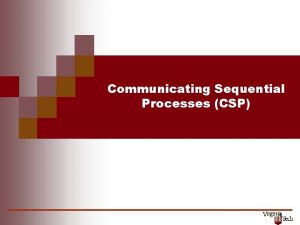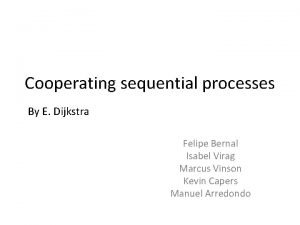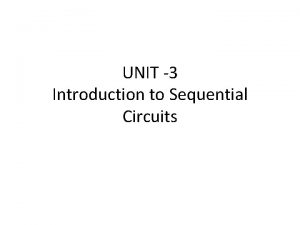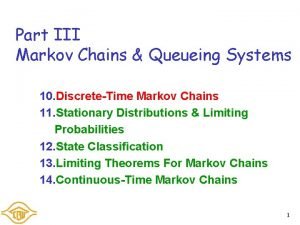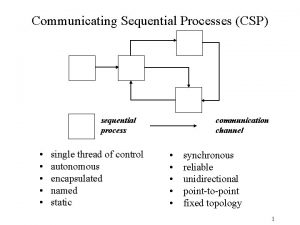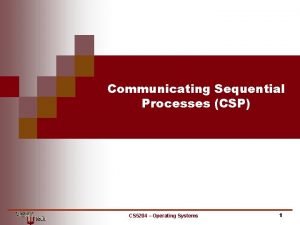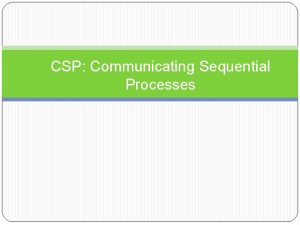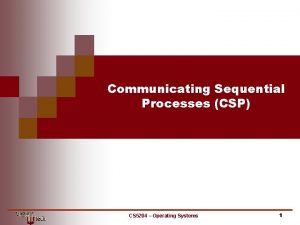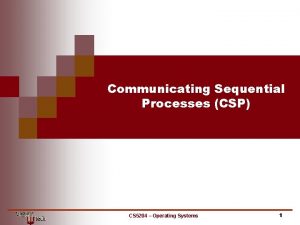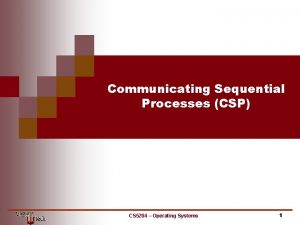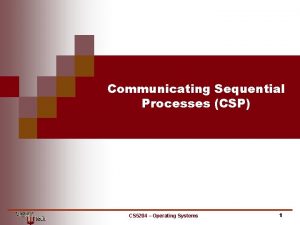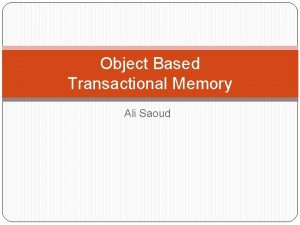Communicating Sequential Processes CSP Ali Saoud CSP Introduction






![CSP Alternative/Repetitive Commands Alternative Command [ G 1 S 1 [] G 2 S CSP Alternative/Repetitive Commands Alternative Command [ G 1 S 1 [] G 2 S](https://slidetodoc.com/presentation_image_h2/3818c55c6e396297fd3938a773c2dff9/image-7.jpg)



- Slides: 10

Communicating Sequential Processes (CSP) Ali Saoud

CSP Introduction n Traditional stored program digital computer has been designed primarily for deterministic execution of a single sequential program. Desire for greater speed has led to the introduction of parallelism. Parallel computing => communication, synchronization, reliability, expense. CS 5204 – Fall, 2009

CSP Introduction Solution: n n n Guarded command: sequential, non-determinism control. Parallel commands start simultaneously with consistent sequential commands. Simple input and output commands. Sender and receiver name each other. Input commands may appear in guards. Repetitive commands may have input commands. CS 5204 – Fall, 2009

CSP Characteristics n n n n Single thread of control Autonomous Static Synchronous Reliable Point –to Point Unidirectional CS 5204 – Fall, 2009

CSP Commands n n n Structured Command: Succeeds if all constituent commands succeed. <SC>: : =<PC>|<AC>|<RC> Null command: Never fails. Command list: Sequential commands. Parallel Commands: Disjoint, concurrent process execution. <PC>: : =[<process>{||<process>}] Assignment Command: insert(n): =has(n+1). Fail. Input/Output command: Send: B!x. Receive: A? y. Blocks if not ready. Variables must match. CS 5204 – Fall, 2009

CSP Guarded Commands <guard> <command list> boolean expression Examples at most one ? , must be at end of guard, considered true iff message pending n < 10 A!index(n); n : = n + 1; n < 10; A? index(n) next = My. Array(n); (i: l. . n)G CL stands for G 1 CLI[]G 2 CL 2[]. . . []Gn CLn CS 5204 – Fall, 2009 6
![CSP AlternativeRepetitive Commands Alternative Command G 1 S 1 G 2 S CSP Alternative/Repetitive Commands Alternative Command [ G 1 S 1 [] G 2 S](https://slidetodoc.com/presentation_image_h2/3818c55c6e396297fd3938a773c2dff9/image-7.jpg)
CSP Alternative/Repetitive Commands Alternative Command [ G 1 S 1 [] G 2 S 2 []. . . [] Gn Sn ] 1. evaluate all guards 2. if more than on guard is true, nondeterministically select one. 3. if no guard is true, terminate. Note: if all true guards end with an input command for which there is no pending message, then delay the evaluation until a message arrives. If all senders have terminated, then the alternative command terminates. Repetitive Command * [ G 1 S 1 [] G 2 S 2 []. . . [] Gn Sn ] repeatedly execute the alternative command until it terminates Examples: [x >= y > m : = x [] y >= x > m : = y ] *[ c: character; west? c > east!c ] CS 5204 – Fall, 2009 7

CSP Coroutines n n n Coroutines are fundamental program structures. Copy: X: : *[c: character; west? c east!c] Squash: Substitute Character in a messege Disassemble: from card file to X=> extra space at the end of card must be added. Assemble: To print from X 125 char/line and complete with spaces. Reformat: Assemble and disassemble CS 5204 – Fall, 2008

CSP Subroutines A corountine acting as a subroutine=>executed concurrently with user process n Function: Division with remainder. [Div: : *[x, y: integer; X? (x, y) quot, rem: integer; quote=0; rem: =x; *[ rem>= y rem= rem-y; quot: = quote+1]; X!(quot, rem)]|| X: : USER n Recursion: Factorial n Data Representation: small set of integers n CS 5204 – Fall, 2008

CSP Monitors and scheduling n Dining philosophers: Phil=*[…during ith lifetime… Think; room!enter; fork(i)!pickup(); fork((i+1)mod 5)!pickup(); EAT; fork(i)!pickup(); fork((i+1)mod 5)!pickup(); Room!exit()] Parallel components: [room: : ROOM||fork(i: 0. . 4): : FORK||phil(i: 0. . 4): : PHIL] CS 5204 – Fall, 2008
 Communicating sequential processes example
Communicating sequential processes example Communicating vs non communicating hydrocele
Communicating vs non communicating hydrocele Cooperating sequential processes
Cooperating sequential processes Concurrent processes are processes that
Concurrent processes are processes that D flip flop
D flip flop Introduction to manufacturing process
Introduction to manufacturing process Introduction to stochastic processes pdf
Introduction to stochastic processes pdf Communicating without words
Communicating without words Aperiodic markov chain
Aperiodic markov chain Nph symptoms
Nph symptoms Communicating value in marketing management
Communicating value in marketing management
